Laos
Things to DO
Huay Xai
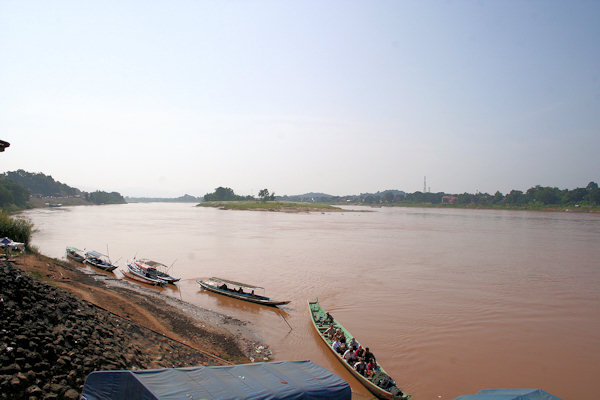 |
|||||
This bustling river port on the Mekong is in a slow and steady state of flux, encouraged by tourist dollars and Thai, Lao
and Chines trade.
The crux of town only spans a few hundred metres and the main street is a strip of guesthouses, shops and tour operators.
Most visitors head here solely for the opportunity to take a slow boat journey on the Mekong, or to head nort for a visit to the
Bokeo Province.
Border crossing out of Thailand is easy; there is a Lao immigration post alongside the pedestrian ferry landing. Thirty-day tourist
visas are available for USA$ 30.
Vieng Phoukha
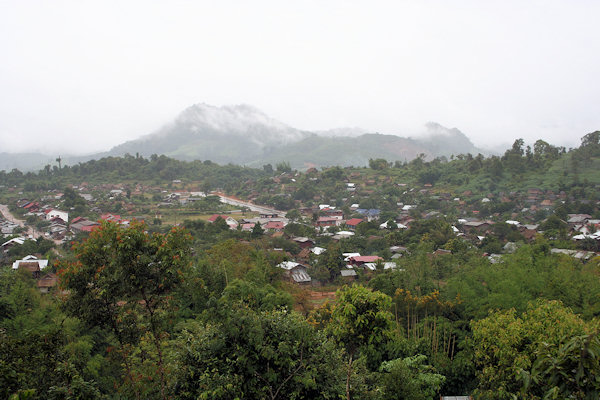 |
|||||
Blessed with a mountainous tapestry, a vast protected area and diverse ethnic villages Luang Nam Tha province
is synonymous with culture, adventure and trekking for most travellers.
Although much of the province is untamed wilderness, the infrastructure to explore it is some of the best in Laos.
Vieng Phoukha is a pleasant trading town largely populated by Khamu farmers and mine workers, and it houses a nice
morning market
The tours from Vieng Phoukha, into the Nam Ha NPA have been most recently established and see the least amount of tourist traffic.
An even blend off village visits and trekking, they are an excellent oppurtunity for people looking to get off the beaten track.
Nam Ha
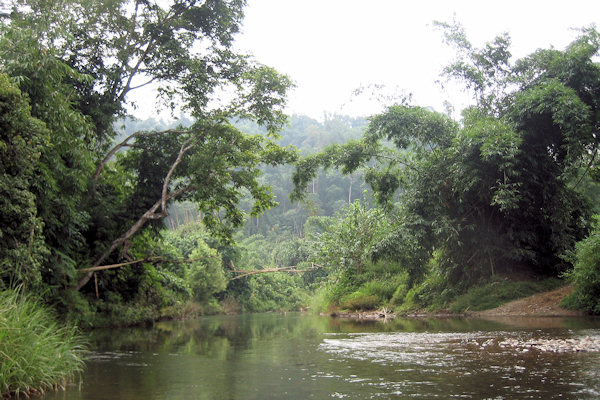 |
|||||
Nam Ha National Protected Area comprises 222.400 hectares of land ranging from the lowlands of the Luang
Namtha Plain to 2.000 meter peaks of its northern highlands.
The park includes some of the most significant and largest contiguous wilderness areas in Laos. The altitude ranges form 560
meters on the plain to 2.094 meters at the highest peak and thus, supports a wide variety of flora
In addition to diverse flora and fauna, the Nam Ha NPA is also home to people. There are 25 villages inside the protected area
and 86 villages just outside its borders. The majority of people living in the remote villages inside and around the protected
area are of the Akha, Lantaen, Khamu and Hmong ethnic groups.
The large pool of trained guides enables each to lead about one trek a month. This ensures an even distribution of proceeds, and
more importantly, it prevents communities from becoming dependent on tourism.
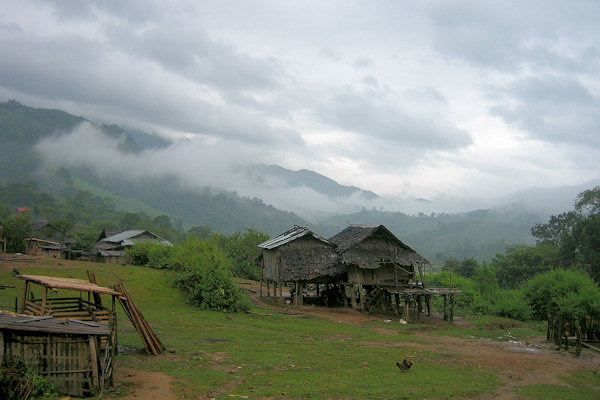 |
|||||
Akha Minority
Akha women have a spectacular appearance, with their heavily ornamented peaked headdress. Made from materials as diverse as beaten
silver, gibbon fur, beads, seeds and feathered tassels.
Far from being an ornament only for festivals and tourists, the Akha women remove it only for cleaning, repair, and for washing their
hair.
The Akha believe a host of spirits dwell inside and outside the village, including a spirit called the "Lord of Land and Water".
They also believe in a supreme deity, Apoe Miyeh.
The Akha's religious philosophy, called Akhazang ("Akha-way"), permeates every aspect of their lives. Akhazang is more
than a religion; it is a social, moral and spiritual code that guides day to day living from ceremonies to house-building,
rice-planting and relationships with one another and with outsiders.
Udomxai
Most of the Udomxai Province population of 265.000 is a mixture of some 23 ethnic minorities mostly
Mien, Phu Thai, Lamet, Lao Huay and Yunnanese Chinese The Yunnanese presence continues to intensify
with the influx of Chinese skilled labourers working in construction and cash crops,as well as traders from Kumming.
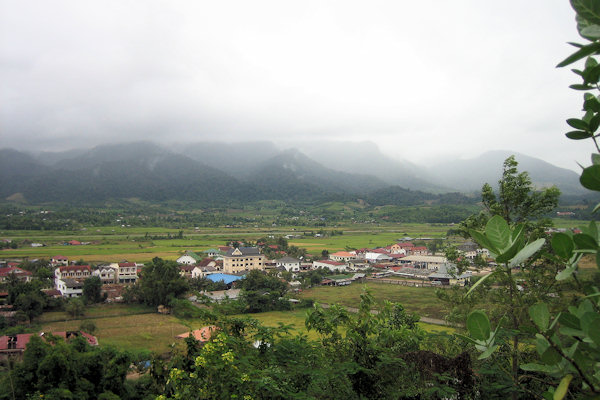 |
|||||
In the 1960s and 1970s the Chinese were appreciated in Udomxai because they donated a network of two-lane paved roads, vital in
moving Pathet Lao and North Vietnamese Army troops and supplies around the north during the war.
Followingthe 1979 ideological split over Cambodia (China sided with the Khmer Rouge, Laos with Vietnam), the Chinese withdrew
all support until the 1990's
Udomxai is a booming Laos-China trade centre riding on imported Chinese wealth. Modest in size, it features tidy asphalt
strips lined with modern buildings and some very comely houses.
More traditional thatched houses are spread across the rim of the valley towards the base of the surrounding mountain range. If you get
off the main street you can find some very picturesque villagelike sections
Otherwise take a short climb to the Ming Meuang Stupa; with excelent vieuws off the surrounding. erea.
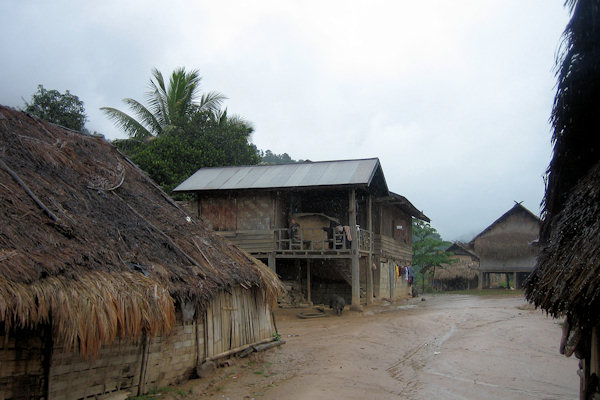 |
|||||
Lao Huay Minority
The Lao Huay, also known as Laen Taen "Dressed in Blue", originally come out of Mongolia; they build their homes - multifamily
longhouses of palm and bamboo tatch - beside rivers or streams from witch they irrigate rice fields using simple wooden hydraulic
pumps.
Lao Huay woman can be identified by the single large coin (usually an old Indochina plastre, sometimes accompanied by several smaller
coins) suspended over the parting in their long, straight hair and by the lack of eyebrows, which are completely depilated at age 15
according to custom.
The Lao Huay use Chinese characters to write their language, often on handmade bamboo paper.
Their belief system encompasses a mix of Taoism, ancestor worship and animism, with spirits attached to the family, house, village,
sky, forest, earth, water and birds.
Nong Khiaw
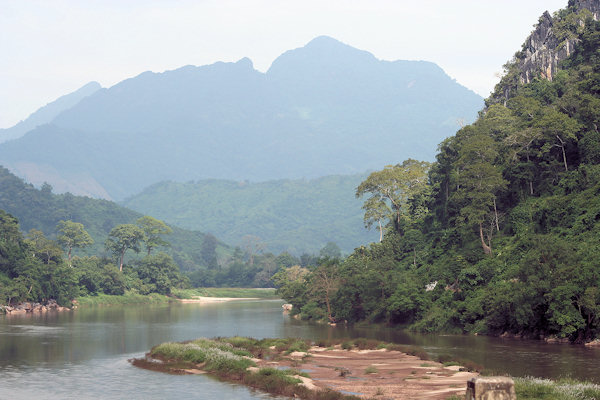 |
|||||
Nong Khiaw is a sleepy market village with a humbling backdrop in northern Luang Prabang Province.
It dozes on the west bank of the Nam Ou, which cuts a languid swathe between close mountains, soaring in a haphazard tumble
of slate and green.
Arriving at the town's dry and dusty bus stop isn't the best introduction, but once venture out, particularly if you cross the
striking bridge to Ban Sop Houn, where the Nam Ou meets the Nam Houn, the surrounding scenery rears in dramatic form.
A 40-minute walk further on leads to Tham Pha Thok, a limestone cave where villagers lived during the Second Indochina War.
To find the cave, walk 2,5 km east of the bridge along Rt1, then look for a clearly visible cave mouth in a limestone cliff to your
right, about 100m from the road. Descend along a path from the road to reach the cave.
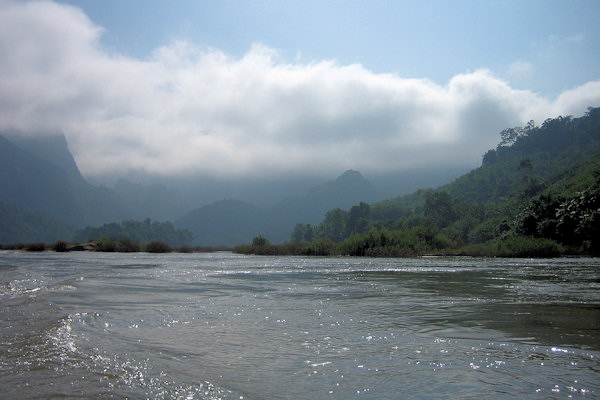 |
|||||
Boat travel along the Nam Ou south of Nong Khiaw has largely been eclipsed by travel along the improved Rte 13, but it's
still possible.
Slow boats will take about five hours and lead you through awesome scenery off cliffs of karst and people living on the riverside.
Be sure to inquire thoroughly to river conditions, as from mid-February on it's not unusual to get stranded.
At the mouth of the Nam Ou, where it reaches the Mekong river are the famous Pak Ou Caves.
Two caves in the lower part of a limestone cliff facing the river are crammed with Buddha images of all styles and sizes.
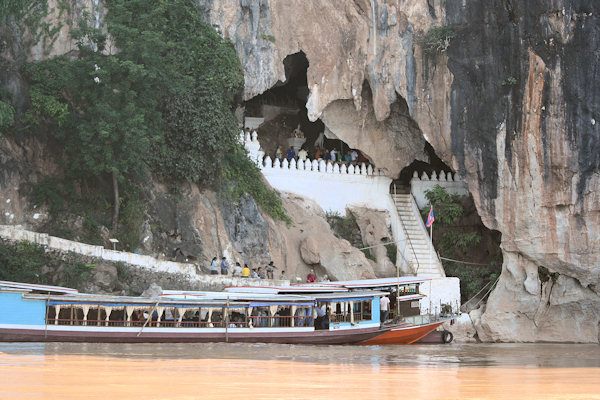 |
|||||
The lower cave, know as Tham Ting, is entered from the river by a series of steps and can easily been seen in daylight.
Stairs to the left of Tham Ting lead around to the upper cave, Tham Phum, which is deeper and requires a artificial light
for viewing - bring a torch (flashlight) if you want to see both caves.
It is believed that the Lao people first entered the river valley in the middle of the eight century after moving southward
from south China.
By the 16th century Buddhism had been accepted by the royal families of Lao, and from that time every year the king and the
people off Luang Prabang made a pilgrimage to to the caves as part off the New Year religious ceremony.
Artisans were commissioned by the royal family to prepare sculptures, which dates from between the 18th to 20th century.